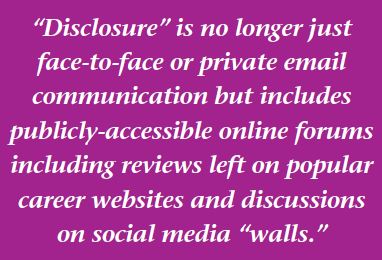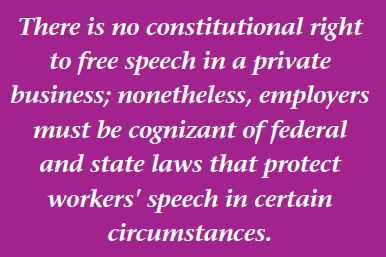Urgent message: Nondisclosure agreements that are commonly required of management and providers to protect a company’s business strategies, intellectual property and human capital generally cannot prohibit employees from sharing their own pay, benefits, working conditions, or conditions of employment even on social media.
Alan A. Ayers, MBA, MAcc is President of Experity Networks and is Practice Management Editor of The Journal of Urgent Care Medicine
Many companies expect and even demand confidentiality of proprietary information. In the urgent care industry, this includes growth and development plans (ie, market research on new locations), operations manuals, patient and other customer lists,1 marketing plans, financial data and other performance metrics, and insurance contracts, along with other information unique to a business that would benefit competitors or be used to damage the company if disclosed inappropriately.
A common issue in every business—including urgent care centers—is employees who discuss their pay with one another or post their salaries on public websites. This is not limited to staff but can include highly compensated physicians, physician assistants, and nurse practitioners. Needless to say, when these comparisons are made it can disrupt the workforce and cause inefficiencies and low morale.
Because of this, many urgent care owners and managers ask if an employer can include discussions of pay, benefits, working conditions, and other aspects of the workplace in a confidentiality agreement. This article will examine what is legally permitted and/or what must be excluded from confidentiality agreements.
A confidentiality agreement (also called a nondisclosure agreement or an NDA) is a legally binding contract where an employee promises to keep proprietary information confidential and refrain from disclosing this information without authorization.2

The Parameters of the National Labor Relations Act
Congress enacted the National Labor Relations Act (NLRA) in 1935 “to protect the rights of employees and employers, to encourage collective bargaining, and to curtail certain private-sector labor and management practices, which can harm the general welfare of workers, businesses and the U.S. economy.”3 The NLRA applies to most private-sector employers, including manufacturers, retailers, private universities, and healthcare facilities.4 Note that both employees at union and nonunion workplaces have protections under the Act.
The NLRA states that employees have the right to unionize, to join together to advance their interests as employees, and to refrain from such activity.5 It also makes it unlawful for an employer to interfere with, restrain, or coerce employees in the exercise of their rights.5
An employee may seek remedy for an employer’s violation of Section 8(a)(1) by filing an unfair labor practice (ULP) charge with the National Labor Relations Board (NLRB).
The Test for Protection under the Act
Whether a given action is protected under the NLRA depends in large part on whether its primary purpose is to fulfill one of the Act’s stated objectives.
Whether an employer’s policy violates the NLRA depends on 1) whether and to what level the policy interferes with the ability of employees to exercise their rights under the Act; and 2) whether the employer has any legitimate business justifications for enforcing such a policy.6

The NLRA protects employees’ right to talk about the terms and conditions of their employment, including discussing their wages with coworkers. And employees have the right to discuss possible unlawful conduct in the workplace, such as illegal harassment, discrimination, and workplace safety violations.7
Social Media
Social media is a major concern today, and in some states employees have the right to engage in lawful conduct during their off-hours, some of which may affect the way the employer’s social media policies are developed. Moreover, employers must take care to not violate the NLRA when disciplining employees for their social media activities.7
An employee’s social media posts may be considered a protected concerted activity if the employee is discussing working conditions and other labor relations matters. In 2017, the U.S. Court of Appeals for the Second Circuit held affirmed the NLRB’s determination that the employer violated Sections 8(a)(1) and 8(a)(3) of the NLRA by discharging an employee since his conduct was not so “opprobrious” or critical as to lose the protection of the NLRA.8 The Court applied the “totality of the circumstances” test for evaluating an employee’s use of social media, which includes considering the following factors:
- any evidence of antiunion hostility
- whether the conduct was provoked
- whether the conduct was impulsive or deliberate
- the location of the conduct
- the subject matter of the conduct
- the nature of the content
- whether the employer considered similar content to be offensive
- whether the employer maintained a specific rule prohibiting the content at issue
- whether the discipline imposed was typical for similar violations or proportionate to the offense.8
In fact, an employer should not conclude that extremely foul language—even when directed at the family of the business owner or a manager—is enough to take the speech beyond the NLRA’s protection. In determining whether conduct is so opprobrious that it loses NLRA protection, courts may consider whether profanity is commonplace in that workplace.9 Moreover, courts will also likely make a distinction between opprobrious conduct that happens in real-time before customers or coworkers and that which that occurs on social media—giving more tolerance for the latter.10-12
Confidentiality Agreements in Urgent Care as a Condition of Employment
In general, employers should be aware of making a confidentiality agreement too broad. This is where an employer can run into trouble and courts may strike down as unreasonable and unenforceable in full or limit the scope of an overly broad confidentiality agreement.13,14
Nondisclosure agreements (NDAs) can include provisions that define the nature and scope of the protected information, the measures the receiving party must take to safeguard the information, the circle of people with access to the information, how the receiving party can use the information, what must be done with the information once the relationship ends, and the remedies available if the receiving party breaches the NDA.15,16
However, an NDA that is overly restrictive as to geographic territory, duration, or scope of activities will be invalidated by the courts.17,18 For example, under Maryland state law, there are four elements that must be satisfied for a restrictive covenant to be enforceable:
- the employer must have a legally protected interest;
- the covenant must not be wider in scope and duration than is reasonably necessary to protect the employer’s interest;
- the covenant cannot impose an undue hardship on the employee; and
- the covenant cannot violate public policy.19-22
Takeaway
Urgent care owners should be cautious in making a confidentiality agreement or NDA a condition of employment. Consult with legal counsel to make certain that an urgent care’s confidentiality agreement or NDA is not overly restrictive as to geographic territory, duration, or the scope of activities.
References
- Health Insurance Portability and Accountability Act of 1996 (HIPAA). Available at: https://www.cdc.gov/phlp/publications/topic/hipaa.html. Accessed July 21, 2021.
- Doyle A. Employee confidentiality and non-disclosure agreements. The Balance Careers. October 25, 2020. Available at: https://www.thebalancecareers.com/what-to-look-for-in-an-employee-confidentiality-agreement-2061955#. Accessed July 21, 2021.
- National Labor Relations Board. National Labor Relations Act. Available at: https://www.nlrb.gov/guidance/key-reference-materials/national-labor-relations-act. Accessed July 21, 2021.
- National Labor Relations Board. Frequently Asked Questions – NLRB. Available at: https://www.nlrb.gov/resources/faq/nlrb. Accessed July 21, 2021.
- Interfering with Employee Rights (Section 7 & 8(a)(1)), National Labor Relations Board. Available at: https://www.nlrb.gov/about-nlrb/rights-we-protect/the-law/interfering-with-employee-rights-section-7-8a1#:~:text=It%20is%20unlawful%20for%20an,they%20forget%20about%20the%20union. Accessed July 21, 2021.
- Speak No Evil – The Right To Limit Employee Speech This Election Season And Beyond. Fisher Phillips. October 7, 2020. Retrieved at https://www.fisherphillips.com/news-insights/speak-no-evil-the-right-to-limit-employee-speech-this-election-season-and-beyond.html. Accessed July 21, 2021.
- Lisa Nagele-Piazza, What employee speech is protected in the workplace? SHRM. July 23, 2018. Available at: https://www.shrm.org/resourcesandtools/legal-and-compliance/employment-law/pages/employee-free-speech-in-the-workplace.aspx. Accessed July 21, 2021.
- NLRB v Pier Sixty, LLC, 855 F.3d 115, 117 (2d Cir. 2017).
- White LA. Using profanity on social media can be protected union-related speech. SHRM. (June 7, 2017). Available at: https://www.shrm.org/ResourcesAndTools/legal-and-compliance/employment-law/pages/court-report-profanity-social-media.aspx. Accessed July 21, 2021.
- Novelis Corp. v NLRB, 885 F.3d 100, 103-04 (2d Cir. 2018).
- MikLin Enters., Inc. v NLRB, 861 F.3d 812, 815 (8th Cir. 2017).
- Three D, LLC v NLRB, 629 F. App’x 33, 35 (2d Cir. 2015).
- Caddick v Tasty Baking Co., No. 2:19-cv-02106-JDW, 2021 U.S. Dist. LEXIS 70016, at *25 (E.D. Pa. Apr. 12, 2021).
- GlobalTranz Enters. Inc. v Murphy, No. CV-18-04819-PHX-ROS, 2021 U.S. Dist. LEXIS 58689, at *17 (D. Ariz. Mar. 26, 2021)
- Adcor Indus. v Beretta U.S.A. Corp., No. 0118, 2021 Md. App. LEXIS 264, at *1 (Md. App. Apr. 1, 2021).
- Vogeler W. Is your company’s confidentiality agreement illegal? FINDLAW (January 19, 2017). Available at: https://blogs.findlaw.com/in_house/2017/01/is-your-companys-confidentiality-agreement-illegal.html. Accessed July 21, 2021.
- Bite Busters, LLC v Burris, 2021 NCBC 19, 1, 2021 NCBC LEXIS 26 (N.C. Superior Court March 25, 2021).
- United Healthcare Servs. v Corzine, No. 2:21-cv-319, 2021 U.S. Dist. LEXIS 47420, at *1 (S.D. Ohio Mar. 15, 2021).
- Reilly v Premier Polymers, L.L.C., No. 14-19-00336-CV, 2020 Tex. App. LEXIS 9385, at *1 (Tex. App. Dec. 3, 2020).
- Houserman v Comtech Telcoms. Corp., No. 2:19-CV-00336-RAJ, 2021 U.S. Dist. LEXIS 20885, at *1 (W.D. Wash. Feb. 3, 2021)
Read Similar Articles
- Implications Of HIPAA And Employee Confidentiality Rules On Positive Drug Test Results
- The Consequences Of A Medical Provider Quitting Without Notice
- The Importance And Validity Of Nondisclosure And Nonsolicitation Clauses For Urgent Care Center Owners
- Responding To Personal Technology In The Urgent Care Workplace

